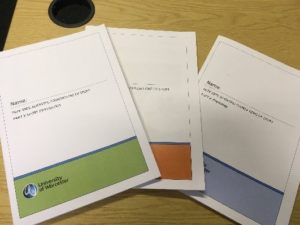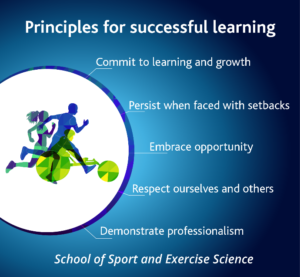Using Workbooks to Create Effective Learning Environments
By Gavin Thomas; School of Sport and Exercise Science
This case study documents the use of workbooks for students studying scientific modules on the sports, coaching and physical education HND, and its positive impact on supporting (A2) and creating effective learning environments (A4). The rationale was to provide an interactive resource in order to enhance engagement and support understanding of complex topics associated with the subject area.

Having been a module leader for several years, I had acquired a comprehensive understanding of the learning outcomes, module syllabus and assessment requirements. This enabled me to create a workbook that integrated the elements of learning from weekly lectures/seminars as well as incorporating essential assessment information (V1). Information about the module content and the structure of the workbook was included in the opening sections, alongside the School of Sport’s 5 principles for successful learning. This is a whole School strategy which aims to foster positive engagement with learning and set clear expectations to promote positive attitudes, behaviours and achievements for all School of Sport and Exercise Science students.

It was made clear in week one to students that the 5 principles should underpin their approach to their studies and attitude on the module. Students were asked to reflect and identify what they could do to ensure these principles were met and, to outline their expectations from their tutor. This initial task embedded in their workbook helped to develop ownership and create well-motivated students (V2). Each week the content delivered in the lecture/seminar would be supplemented through use of the workbook. For example, the workbook contained a series of questions for students to discuss, debate and answer at the start of each session. This helped to increase interaction and collaborative learning from the start and resonates with the work of Revell and Wainwright (2009).
To accommodate the range of learners a hard copy or e-copy of the workbook was available (via blackboard). The workbook also contained various tasks and visual aids, such as reflecting on prior knowledge, questions, problems to solve collaboratively, diagrams and YouTube video links related to the topic area. After each taught session the section concluded by offering further reading and space to write down key learning and application to the assessment tasks. One student stated that the workbook “really helped to focus note taking and revising when using for assessments”. Another commented that “the workbooks were useful when writing assessments as the book acted as a checklist for what to include. Also, the workbook assisted in independent learning as it included further reading into different topics”. During module evaluations for all my modules with workbooks, when asked the question ‘Overall I am satisfied with the quality of this module” 100% of students agreed.
Since the HND was established in 2013, the use of workbooks was implemented in 2017 and has contributed to the maintenance of excellent levels of course satisfaction. Using workbooks as an innovative form of practice contributed to achieving 100% overall course satisfaction for four consecutive years (2014-2018). Students were asked to feedback on the effectiveness of workbooks via a questionnaire and results were highly positive (from 22 students out of 48) with 77.3% strongly agreeing and 9.1% agreeing that they would recommend the use of workbooks in other modules. 63.65% strongly agree and 18.2% agree that the workbooks contained detailed information which enabled understanding of assessment tasks.
Research suggests that students using workbooks helps to reduce the mismatch in teaching and learning styles and offers increased interaction that helps to enhance the effectiveness of teaching (Demirel, 2004) (V3) From my experience it was evident that use of workbooks not only increased the students’ confidence going into the sessions’ but also increased my own confidence to experiment with new and innovative ways of teaching.
References
Demirel, Y. (2004) Workbook strategy in engineering education. World Transactions on Engineering and Technology Education, 3 (1), pp. 53-56
Revell, A. and Wainwright, E. (2009) What makes lectures ‘unmissable’? Insights into teaching excellence and active learning. Journal of Geography in Higher Education, 33 (2), pp.209-223
